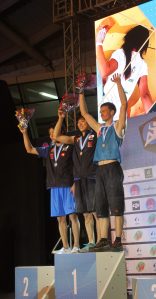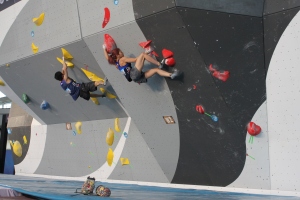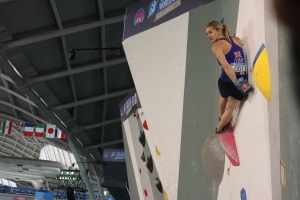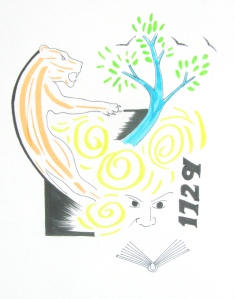
The outdoors isn’t all about achievement. It is also about being there and taking in worlds different from what one is used to. Senior NOLS instructor, Shantanu Pandit, sketched this house in Solang Nallah, Himachal Pradesh, years ago when he was leading the hiking and camping season there for Mumbai based-outdoor company, Countryside (Illustration: Shantanu Pandit)
This article is about a NOLS course I did in 2011. Shantanu Pandit helps bring in a touch of the mountains with his sketches. NOLS courses in India are held in Uttarakhand.
It had been a hard walk.
Not so much for the terrain or the duration. It was the weight in my backpack. I wasn’t used to hauling so much. Plus there was fatigue and ego. Once again in the outdoors, I was on the wrong side of age. I was among the oldest in my batch, if not the oldest. Anger, kindled from an earlier mountaineering course at an Indian institute, where everything had been partial to its dominant age group of the early twenties – worked its way into my blood. New to altitude and snow, I felt I was denied training and instead parceled off into existence as mediocre specimen. The word for it was `grade’; it graced everyone’s certificate like pedigree. From that certificate flowed, for all practical purposes, mountaineering’s hierarchy in India. Not again such imprisonment by grade, I said, as I pulled hard and raced off from everyone else on the first day of a Trip Leader India (TLI) course with the India branch of the National Outdoor Leadership School (NOLS).
Some hours earlier, we had been dropped off on the approach to Karmi village in Kumaon, the eastern half of the Indian state of Uttarakhand. It was hilly all around. As the crow flies, the snow-capped peaks of the Himalaya were not far off. It was day one. The jeeps left and a sense of you-are-on-your-own descended. We would be out for a little less than one month. Just then, the end seemed long way off. I looked at my course mates. Two or three were faces familiar from previous trips to the outdoors. The rest were strangers. The course began systematically with instructors emphasizing foot care (that’s the part of the anatomy you would use the most on a long hike), hydration and periodic breaks for refreshment. But I was in a different world haunted by old memories. I am unsure whether I adhered to the instructors’ advice. I saw the course as another tsunami of youth at my heels, waiting to sink my ship. Evening we halted to camp, gathering in a circle as NOLS loves to do. I remember sitting down on my backpack, in that circle. Then the world tilted like a ship deck heaving in stormy sea. Eventually the ship turned turtle and a peaceful darkness took hold.
On my NOLS course, my planned redemption from `B’ grade at old mountaineering institute, I had fainted!
Damn.

A temple in Solang Nallah, Himachal Pradesh (Illustration: Shantanu Pandit)
We had been divided into tent groups. Each group was self-sufficient in shelter, food and cooking equipment. I don’t quite remember where I woke up or who I saw first. Was it my tent mates? Was it my instructors peering down at me? Anyway, I was told I came around to my senses, with some chocolate. That evening my tent mates quietly took care of me. Nobody made an issue of the fainting spell; nobody bothered me unnecessarily. I introspected, tracing the episode to both old anger and perhaps more importantly, long hours chair-bound before the computer, back in Mumbai where I eked out a living as freelance journalist. Not only had that life been increasingly sedentary but income had drastically dropped too, affecting nutrition. Once a rock climbing addict, I was forced to reduce my visits to the crags after I lost my erstwhile disciplined life to incessant typing. Typing for my life I would say, because as freelancer I was paid only as per what I wrote; there is no salary or security. Now I was paying for it. In my tent, I felt like an idiot. I expected to be sent out, packed back to the NOLS India base in Ranikhet. Such was the legacy of the old mountaineering course in my head. The outdoors is all about performance, right?
Mercifully, that didn’t happen.
We had three instructors. The course leader was Margo van den Berg, an American of Dutch origin. Competent climber, she kept a studied distance from all till we approached course’s end. She carried a sketchbook in which she collected drawings of outdoor scenes. If I recall right, she also liked to dance and did something similar to a polka once. The second instructor was Ariel Greene; American, strong hiker, well read and majored in literature, also accomplished musician. A rather quiet individual, he was capable of engaging conversation on subjects that captured his interest. The third was Pranesh Manchaiah; Indian, at that time one of the best rock climbers in the country. He was very approachable and the active interface of the instructor team with the students. They must have discussed my case. The next morning, they made sure to check on me. I also knew I was probably being observed. But that was it – day two, kicked off like any other day. I had made a mistake. It seemed alright. What mattered more was – would I learn from my mistake?
I liked that approach, that second chance.

Kitchen tent, from a trip in Ladakh years ago (Illustration: Shantanu Pandit)
I sorely needed it. The combination of mountaineering institute, climbing club and my own limitations as climber had jammed me into a funk. An unexpected high altitude hike with a friend, who was a NOLS instructor and the way he taught me some simple steps in snow craft, got me thinking of this outdoor school. How about doing a NOLS course? – I thought. I started with a first aid course, which made sense for I was already working occasionally as an outdoor educator. Even in that course, taught at Ranikhet, the NOLS teaching style stood out. A typical class was of modest size, not the too many which characterized Indian scenarios. Modest size meant better attention and observation. There was fun. Yet there was a high degree of personal ownership among all. That dreaded word `grade,’ which plagued my old mountaineering course wasn’t prominent. The times it grew prominent were when Indian students featured it in their private discussions for we worship life by degrees, grades and such licenses for exclusivity ingrained in us. Worse, unable to live without A, B and C grades for distinction, we focus our teaching efforts on the most promising. At my old mountaineering institute, I remember explicit encouragement and support for the naturally talented, while the stragglers lived like failures. The NOLS faculty on the other hand, seemed to see teaching as exactly that – teaching those who don’t know. Indeed I would say, the less you know something, the better a NOLS course works for you, provided you are there to learn. At the end of the first aid course, there was a test. It went by like a breeze for free of fearing grade and genuinely wanting to be good at what we did, we had studied well every day. Each of us got a certificate valid for two years. NOLS was clear that rusted skills didn’t mean much. After two years, you re-certify.
My experience of the first aid course made me curious. The school’s philosophy seemed to agree with my own belief – you are as good as how often you are in the outdoors, not what grade you hold from an old course at mountaineering institute. I also liked the reduced machismo in the air. Quite unlike the Indian habit of viewing the outdoors as domain of the tough and seeking champions in everything, the tenor at NOLS seemed to be to make people comfortable in the outdoors with the champion bit, left for personal pursuit. What they did was put the basics like risk assessment, camping skills, navigation and Leave No Trace in place. In India, NOLS ran mountaineering and backpacking courses. The regular courses have one major drawback. They are expensive. However the Indian branch had a local outreach programme structured for educators – that’s the one I chose to do after my first aid course.
The first time I heard of NOLS was at my longstanding mountaineering club in Mumbai. We were on a diet of regular rock climbing in the local hills with occasional visits to climb mountains in the Himalaya. We were a rough, tough lot, shaped by climbing and eminently capable of turning our backs on anyone who deemed us crazy. We had need only for each other. What we didn’t know was how much that made us inward looking, measuring everything and everyone through the prism of climbing and to that extent, not different from settled society which views the world through the prism of well settled life. We often poked fun of NOLS, which seemed tame with its emphasis on safety, risk assessment et al and its pronounced appreciation for hiking as right context to teach outdoor curriculum. Climbers look down on hikers. In the company of my club, I submitted myself to measurement by climbing grade, worshiped super humans and wept at my measly strengths in the field. There was also another reason, I guess, why NOLS was looked at the way it was, in the Mumbai climbing circles I was exposed to. Clubs are a great way to start off something. But over a period of time, they can lose the ability to be self critical and become a self righteous fold of the mutually familiar. At the time I did my course, I found NOLS quite different compared to the outdoor club and mountaineering institute, I was coming from.

View from Khardung La, Ladakh (Illustration: Shantanu Pandit)
On our NOLS course, we had contour maps, compasses to orient them; indeed compasses using which we could have gone through the old routine of bearing and back bearing – the works, tying ourselves up in a math most of us hate. At NOLS, past map-orientation, our instructors encouraged us to keep the compass aside. A major component of navigation was observation of context. We slowly learnt to pick out features from the surrounding geography and locate them on the map. Looking around became important. As you looked up from traditional entrapment by performance and immediate world, you saw mountains, passes, even your fellow students. Throughout my NOLS course, I struggled with navigation (I still do). It was an indication of how much I had to get away from tunnel vision and impatience. I remembered my first mountaineering expedition in the Zanskar Himalaya, where I had once spent a long time frantically looking for the rest who had moved fast and disappeared from sight. Since then, having people ahead and within sight had been my map, my sense of security. Now map in hand, I was looking around, using my head even as it loathed math.
Mountains are lovely classrooms. Long hiking days and path-finding often threw up fantastic junctures for an instructor to intervene. Entrusted with responsibility and beset with error and challenge, the students opened up to learning. We learnt to work as a team, co-operate and have fun. I recognized this fun quickly as the inexplicable bonhomie I knew from my climbing crags, that sheer delight of being in the outdoors with others who love it. Describing it is difficult, probably not required. The difference on the NOLS course was this – we discovered it wasn’t magic but something we could create. We were not annoyingly judgmental. We were accommodating, willing to explain our problems with the world and each other, contributing thus to a quality missed in Indian education – a safe learning environment.
For example, I was, still am, a very average cook. But even the worst cook gains confidence and tries to improve when your turn to cook is accompanied by supportive tent mates and cooking is part of field curriculum being taught. That said, for many Indians, cooking is akin to the loss of vertical as stamp of high adventure. What has cooking – usually identified with the ladies – got to do with the macho outdoors? In Indian context with premium on masculinity, it takes the sheen off adventurer expected to handle nothing but ropes and gear. Cooking at NOLS addressed a very fundamental point – if you can’t take care of yourself in the outdoors, how can you say you are adventurer chasing peak, pass or summit? If you exist, your chance of reaching the destination is more. On such simple things ranging from cooking to personal hygiene, listening to team members and learning to lead, ran a NOLS course. The concept of self-sustained expeditions, which form the backbone of all NOLS experiences, is perfect backdrop for these dynamics to unravel.

A scene from just outside Karzyok, Ladakh (Illustration: Shantanu Pandit)
Many days of hiking went by. Roughly put, our route ran east from Karmi towards Munsyari, hugging modest elevation but having enough rough terrain to make the hiking experience span walking on proper trail to bushwhacking. Doing the latter with students as navigators and instructor passively accompanying till the evolving situation warranted intervention, we had some long strenuous days. Split every morning into self-contained hiking groups, I remember one extended day that slowly slid to late evening, destination not yet reached and students beginning to get nervous. Margo who walked with us was however cool. She occasionally checked the geographical features around to gauge direction, played silent spectator to our team management and scouting trips and when darkness approached, stayed calm for after all we were a self-contained group. It brought alive that load in my backpack as my survival kit and not excuse to show-off my ability to haul weight. As things turned out, my group did reach the assigned camping spot to a warm welcome of flying snow balls from the rest of the batch, arrived earlier. It was early summer in the Himalaya. Snow was around in shaded areas and the higher reaches of our route. Often, it rained, making the world wet-cold. Our last camp was at Dhapa, high on the banks of the Goriganga near Munsyari. By then we had crossed two other major river valleys en route, those of the Pindar and Saryu rivers, besides other minor valleys identified with local streams. Every time we climbed up from a valley to height, we would see the snow clad Kumaon Himalaya not far away.
Slowly but steadily, I had become fit as a fiddle; happy to be out. I could have turned around and asked the guy who fainted – are you me? The near 25 kilo-backpacks were a load, no doubt. But we knew the pattern – it weighed most just after re-ration and tapered slowly towards the next re-ration. So we cooked and ate. We attended classes despite weather gone bad, wearing rain coats, puff jackets and wind cheaters under a tarp propped up by tree branches and trekking poles, for shelter. We saw each other in the light of headlamps. We waded through cold streams, kicked steps on snow and bushwhacked. At camps, we took classes; something, anything that you could share with your fellow students or teach them. From strangers, we evolved to friends. I remember young Zanskar, who thanks to his familiarity with Kumaon, was a walking encyclopedia on local flora and fauna. I remember Joshi, who everyone remembers, for the rhododendron-paratha he made. I remember quiet, solid Soumitra. I remember the ever upbeat Amrit. I remember Vinay, Anish, Stanzin, Kamakshi, Tara, Hitendra, Ravi, Manjunath, Shaleel. We got along well.
Then one day, close to course’s end, your instructor – they assigned one as mentor for each student – met up with you to discuss evaluation and grade. I appreciated the personal meeting, the discussion and the detailed evaluation with explanations. A, B, C or shades in between – they told you why. Most important – it wasn’t a certificate that dovetailed as input for a bureaucratic administration of access to the mountains, saying: a person with this grade can do this, that grade can do only so much…so on and so forth. They weren’t gifting me a straight-jacket for life as the Indian mountaineering institute did. The NOLS certificate felt like an evaluation in time, a snapshot in life. What a snapshot shows of you at 20 isn’t how you would be at 40, which in turn may not be how you are at 60. Life is a journey. It is for you to decide what to do with it. A snapshot isn’t all of your life at one go. It is just a slice, a pointer.
I liked that.
I felt free.
(The author, Shyam G Menon, is a freelance journalist based in Mumbai. This article was developed from a piece originally written and published in The Outdoor Journal [http://www.outdoorjournal.in/] in early 2014. My gratitude to Shantanu Pandit for asking me about the old article and making me want to share it afresh.)
































































